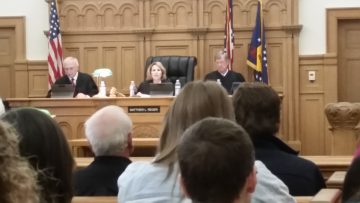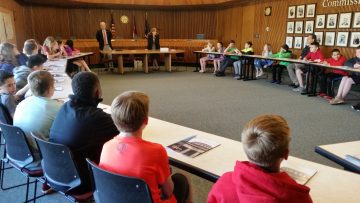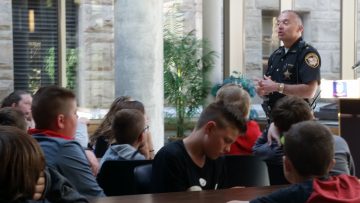By JAN LARSON McLAUGHLIN
BG Independent News
There was a bit of disorder in the courts Monday as Bowling Green sixth graders got a close-up view of “Lady Justice.” They sat in on a court case, they offered ideas for new laws, and they met with the sheriff. And as a bonus, they learned a bit on how the county handles emergencies.
The kids were awestruck by the court proceedings, and suitably impressed by the grand Wood County Courthouse. But kids being kids – they sometimes found a different focus than the intended.
For example, as architect Heidi Reger pointed out the intricate stone work on the front of the 1896 courthouse, she asked the students to find the faces and animals carved into the stone. “They liked to tell a lot of stories in the stones,” she said.

Heidi Reger describes architecture of the courthouse.
But during one group’s tour, Reger had some competition from above when one of the Peregrine falcons roosting in the courthouse clock tower snatched a bird for breakfast. It wasn’t long before a burst of feathers came floating down from the clock tower.
Once inside the courthouse, the students got to listen to cases presented to the Sixth District Court of Appeals. The lesson there might have been that real court cases aren’t necessarily as exciting as those portrayed on television.
But the students sat respectfully with little fidgeting as a case was argued about who was responsible for paying for roadwork and causeway maintenance for Johnson Island. Though the legal arguments were tedious, technical and long-winded, the students sat quietly. One court constable suggested that the sixth graders were likely intimidated by the panel of three robed judges, or by the ornate courtroom with its stained glass ceiling.

Court of Appeal hears cases in front of students.
After sitting through the governmental arm that rules on the law, the students heard from state legislators that make the laws. State Senator Randy Gardner and State Rep. Theresa Gavarone, both R-Bowling Green, talked about their routes to the statehouse. Gardner started out as a teacher, and Gavarone as an attorney and part-owner of Mr. Spots – which seemed to impress the students.
Gardner stressed to the students that they are the bosses of state legislators.
“If you live in Wood County, that means you’re our boss,” he said. “We listen to you.”
Both talked about bills they sponsored that involved kids – such as legislation against bullying, requiring vision screening for students, and allowing students with asthma to carry their own inhalers at school.
Gardner also talked about legislation introduced by students, like the bill designating the white-tailed deer as Ohio’s official state animal.
“It came right from students,” specifically sixth graders who believed Ohio should have a state animal, he said. “It was really pretty cool.”

Randy Gardner and Theresa Gavarone talk about legislation.
Currently, other students in Ohio are working on legislation creating an official state dog. Gardner asked the students to guess the breed under consideration. The guesses included mainstream German shepherds, golden retrievers and Chihuahuas, and more specialized Pomeranian-husky mixes, pit bulls, and Tibetan spaniels.
As it turns out, Gardner said he believes it’s a Labrador retriever being put up for the position.
Gardner asked the students what laws they would like enacted. One suggested a bill against animal abuse. Done that, Gardner said. Another suggested that fidget spinners be allowed in school. Not likely, he said. And a mom mentioned her child’s wishes for a second recess. That would be nice, he agreed.
Then the students met with the governmental arm that enforces the laws – Wood County Sheriff Mark Wasylyshyn. Though life without rules may sound great at first, laws are necessary to keep people safe, he said.

Sheriff Mark Wasylyshyn talks with students.
The students were full of questions for the sheriff.
How much is he paid? The state dictates his salary based on the county’s population, so he makes about $98,000 a year, Wasylyshyn said.
What’s a typical day? It’s always different, he said. There may be issues at the jail, or with the 911 system, or crime out in the community. “My day can change in an instant.” There are also the enjoyable events, like Eagle Scout ceremonies, that he makes a point to attend.
What’s the most common crime in Wood County? Vandalism and theft. “It’s unusual to have a murder in Wood County,” with one or two occurring a year, he said.
What’s the worst thing he’s ever had to deal with? For him, it’s the cases involving kids. Wasylyshyn remembered a particular case from years ago when he found a 12-year-old boy riding his bike on Interstate 75, which wasn’t safe. When he asked where the boy was headed, the child said he was going to Dayton to see his mom. He knew he couldn’t stay with her, but told Wasylyshyn, “I just want to ride my bike down and tell her I love her.”

Judge Matt Reger talks about murals inside courthouse.
Though not related to the legal system, the students also got a bonus stop at the Wood County Emergency Management Agency, where they learned about the local efforts to plan for disasters.
Jeff Klein, assistant director of the EMA, asked the students to list some emergencies that might occur in Wood County. The students were quiet, until Klein gave them incentive to speak. “If you guys aren’t going to speak, there’s going to be a test,” and nothing simple like multiple choice.
That was enough to open the floodgates, with the students then rattling off potential emergencies – tornadoes, floods, fires, hailstones and hurricanes – well at least the tail end of hurricanes.
The government day for the sixth graders is the brainchild of teacher Rob Morgan. Wood County Common Pleas Judge Matt Reger helped expand the program this year.
“We want students to see our government in action, to see what our government does for us – besides cause frustration,” teacher Lane Hakel said with a smile.





